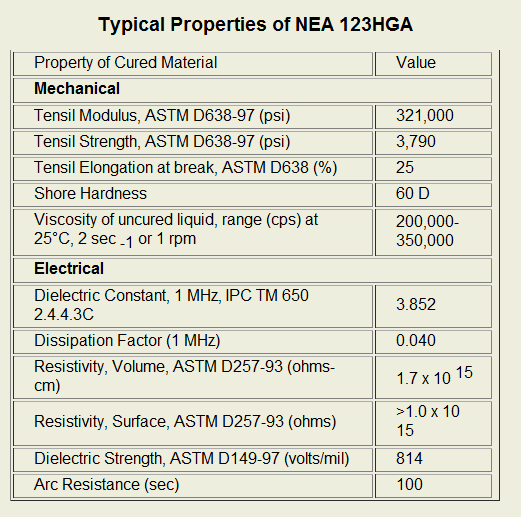- Home
- UV cured adhesives
- Acrylates
- Norland UV adhesives
- Electronic adhesives
- Norland NEA 123 HGA
Norland NEA 123 HGA
NEA 123 HGA is a low outgassing, one part, thixotropic adhesive similar to NEA 123. When exposed to UV light, it cures in seconds to a tack free, tough resilient polymer. After curing, subsequent outgassing is less than that from standard NEA 123. The tensile strength, modulus and the electrical resistivity of NEA 123 HGA are higher than the standard NEA 123; its elongation is less and other properties are comparable.
NEA 123 HGA is recommended as an extremely fast and efficient way to tack, fill, seal or bond precision components or wires in place. Applications include wire tacking, chip capacitor bonding, coil termination, tamper-proofing adjustable components, and bonding of head gimbal assemblies.
A drop of the adhesive is used to form a bridge between the component or wires and the substrate. Exposure to UV light quickly cures the adhesive and holds the components in place. Generally, about 6 joules/cm2 of UV cure energy are required for a full cure. The exact time depends on thickness, lamp intensity and individual requirements.
The adhesive was formulated to respond to the UV-A range of 320 to 390 nm. UV light sources with peak intensity near 365 nm (such as medium pressure mercury, halide or xenon lamps) are very effective. In addition to the UV cure, the NEA 123 HGA contains a latent heat catalyst that can quickly cure areas where the UV light cannot reach. The catalyst allows the adhesive to cure in 10 minutes at 125°C or 3 hours at 80°C. Thermal curing is not necessary if the entire adhesive receives proper UV light. Heating a light-cured material may be redundant but will not be harmful and generally lowers the outgassing.
Oxygen inhibition is not a problem at 125°C, but at lower temperatures, adhesive directly exposed to air may still be tacky. An inert atmosphere (nitrogen) will allow tack-free low temperature curing. Below 70°C, curing is not practical. The cure process is exothermic whether accomplished by light or heat. Test samples should be allowed to return to room temperature before evaluating.
Adhesion of NEA 123 HGA is excellent for glass, silica, stainless steel, aluminum, copper and metals in general. Adhesion to plastics is fair to good for polypropylene, polycarbonate, acrylics, vinyl and polyacetal (DuPont’s Delrin®).


NEA 123 HGA may cause skin sensitization in some susceptible individuals. Avoid prolonged skin contact. We recommend wearing gloves made of latex or other impervious material. If contact occurs, wash with soap and water. Alcohol or other solvents should not be used for washing because they may remove the protective oils from skin. While the vapor pressure of NEA 123 HGA is low and the fumes not especially toxic, good manufacturing procedures dictate adequate ventilation. Read the accompanying MSDS for more details.
Although Norland Products’ adhesives cure in seconds on exposure to UV light, they are very stable when not exposed to UV or excessive heat. Store in a cool, dark place. Refrigeration, while not generally necessary, is an ideal way to store NEA 123 HGA. If refrigerated, allow the material to come to room temperature before using. Exposure to direct sunlight or heat can cause an exothermic reaction and must be avoided.
